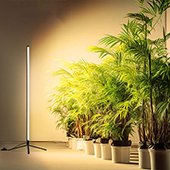When it comes to the light cycle, it’s like a biological clock bestowed upon plants by nature. It determines when plants grow when they rest, and even when they enter the flowering stage.
The photoperiod theory is essentially about how sensitive plants are to the length of daylight in a day, acting as a calendar for plants to judge when to enter the next growth stage.
Each plant has its daily routine. Some plants prefer staying up late, known as long-day plants, as they only start flowering when the days are long enough. Common examples include spinach and rapeseed, which require sufficient sunlight during the day to happily produce flowers.
On the contrary, there are also early-to-bed, early-to-rise plants, known as short-day plants, such as some ornamental flowers. They only sense the arrival of spring when the days are short, prompting them to start nurturing flowers.
When it comes to setting specific lighting schedules, it depends on the type of plants we are nurturing. For example, if we are growing vegetables, we need to determine whether they are “night owls” or “early birds.”
During their growth stage, plants may require longer periods of light to accelerate leaf growth and nutrient accumulation. However, during the reproductive stage, we need to adjust the lighting according to their preferred photoperiod to ensure timely flowering and fruiting.
In summary, different plants have different lighting needs at different stages of growth, much like how we have varying food preferences.
Seeds in their infancy may only require faint light to awaken their dormant vitality, while mature plants may need ample sunlight to ensure healthy growth.
We must learn to observe and understand the habits of our plant babies and cleverly use LED grow lights to simulate appropriate day lengths, helping them thrive happily in any environment.




